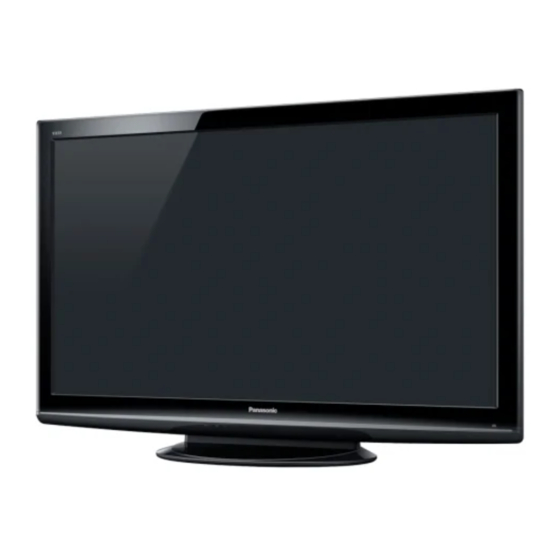Table of Contents
Advertisement
Please read these instructions before operating your set and retain them for future reference.
The images shown in this manual are for illustrative purposes only.
Please refer to Pan European Guarantee Card if you need to contact your local Panasonic dealer for assistance.
English
Operating Instructions
Plasma Television
TX-P37X10E
Model No.
TX-P42X10E
TX-P50X10E
TQB0E0791U-1
Advertisement
Table of Contents

Summarization of Contents
media excitement
Enjoy rich multi-media
Highlights the TV's multi-media capabilities and features.
Safety Precautions
Mains Plug and Lead Safety
Instructions for safely connecting and handling the power cord and plug to prevent hazards.
Environmental and Placement Safety
Precautions regarding power source, moisture, heat, foreign objects, and unstable surfaces.
Equipment Handling and Usage Safety
Guidelines for safe placement, use of pedestals, and handling the heavy TV set.
Important Usage Notes and Maintenance
Notes on image retention, auto standby, cleaning, and avoiding specific equipment.
Accessories and Setup
Accessories and Options
Lists standard and optional accessories supplied with or available for the TV.
Attaching the Pedestal
Detailed steps and safety warnings for assembling and securing the TV's pedestal.
Controls and Operation
Identifying TV and Remote Controls
Overview of TV terminals, buttons, LEDs, sensors, and remote control functions.
Basic Connection
Connecting External Equipment
Diagrams and instructions for connecting aerials, DVD recorders, VCRs, and set-top boxes.
Example 3: Connecting Multiple Devices
Instructions for connecting DVD recorders and set-top boxes simultaneously.
Initial Setup
Auto Setup Process
Step-by-step guide for automatically searching and storing TV channels.
Using On-Screen Displays
Guidance on navigating menus and using the remote control for TV settings.
Watching TV
Basic TV Viewing and Channel Selection
Instructions for turning on the TV, selecting modes, and tuning channels.
Advanced TV Functions
Details on using Hold, Information Banner, Subtitles, Aspect Ratio, and Off Timer.
Using TV Guide
Viewing the Programme Guide
How to access and navigate the Electronic Programme Guide (EPG) for channel listings.
GUIDE Plus+ System Features
Information on using the GUIDE Plus+ system and managing advertisement displays.
Viewing Teletext
Teletext Modes and Navigation
Explanation of FLOF, TOP, and List modes, and basic teletext navigation.
Advanced Teletext Operations
Instructions for using Index, favourite pages, multi-window view, and updating pages.
Watching External Inputs
Connecting and Selecting External Sources
Guide to connecting external equipment and selecting input modes.
Operating Connected Equipment Remotely
How to control connected devices like DVD recorders or VCRs using the TV remote.
How to Use Menu Functions
Picture Menu Settings
Detailed settings for picture quality, including Viewing Mode, Contrast, Colour, and Eco Mode.
Sound Menu Settings
Adjustments for sound modes, bass, treble, balance, volume, and speaker settings.
Setup Menu Options
Covers Link Settings, Tuning Menus, Language, Display, Common Interface, System, and Other Settings.
Retuning Channels
DVB-T Channel Retuning
Steps to automatically retune DVB-T channels and update channel information.
Analogue Channel Retuning
Steps to automatically retune Analogue channels and manage channel data.
Tuning and Editing Channels
DVB Channel Management
How to select DVB-T, update channels, and check signal conditions.
DVB Favourites and Channel List
Creating favourite channel lists and skipping/editing channels in DVB mode.
Analogue Channel Management
Steps for selecting Analogue channels and performing Auto Setup.
Analogue Favourites and Channel List
Skipping and editing Analogue channels, and manual tuning.
Child Lock
Controlling Channel Access
How to lock specific channels or inputs and manage PIN numbers.
Input Labels
Customizing Input Labels
Procedure to label or skip input terminals for easier identification.
Using Common Interface
CI Module Operations
Guide to inserting and using a Common Interface (CI) module for pay-TV services.
Shipping Condition
Resetting TV to Factory Settings
Instructions for resetting the TV to its original condition and initial setup.
Updating TV Software
Software Update Procedures
Steps for downloading and installing TV software updates automatically or manually.
System Update Operations
Details on automatic vs. immediate system updates and download process.
Displaying PC Screen on TV
Connecting and Displaying PC
How to connect a PC and display its screen, including PC menu settings.
How to Use VIERA TOOLS
Accessing VIERA TOOLS Features
Guide to accessing and using special features like VIERA Link Control and Pause Live TV.
Viewing from SD Card
SD Card Operations (VIERA IMAGE VIEWER)
How to insert, view, and manage photos from an SD card using the TV.
Slideshow Functionality
Instructions for setting up and displaying photo slideshows with background music and intervals.
Link Functions
Q-Link and VIERA Link Overview
Summary of features and connection requirements for Q-Link and VIERA Link.
VIERA Link Features and Operations
Detailed explanation of VIERA Link functions like HDAVI Control, Pause Live TV, and Speaker Control.
Q-Link Specific Features
Details on Q-Link preparations, direct TV recording, and power link functions.
VIERA Link “HDAVI Control TM ”
HDAVI Control Features and Preparations
Information on HDAVI Control compatibility, connections, and feature availability.
External Equipment
Connection Recommendations
Diagrams and tables showing recommended connections for various external devices.
Terminal Compatibility
Details on which types of equipment can connect to each TV terminal.
Technical Information
Auto Aspect and Signal Compatibility
Details on automatic aspect ratio adjustment and supported input signal formats.
SD Card and Terminal Specifications
Information on SD card handling, messages, characters table, and terminal pinouts.
HDMI and PC Connection Specifications
Specifications for HDMI connections and PC input signals.
FAQs and Troubleshooting
Common TV Problems and Solutions
Solutions for common issues like image noise, no sound, or display problems.
Advanced Troubleshooting Scenarios
Guidance for resolving complex issues related to DVB, HDMI, and remote control problems.
Specifications
TV Model Technical Data
Technical data including power, dimensions, display size, and input/output terminals.
User Information
Disposal, Licence, and Record Keeping
Guidelines for recycling old equipment, licensing details, and customer record keeping.













Need help?
Do you have a question about the Viera TX-P50X10E and is the answer not in the manual?
Questions and answers